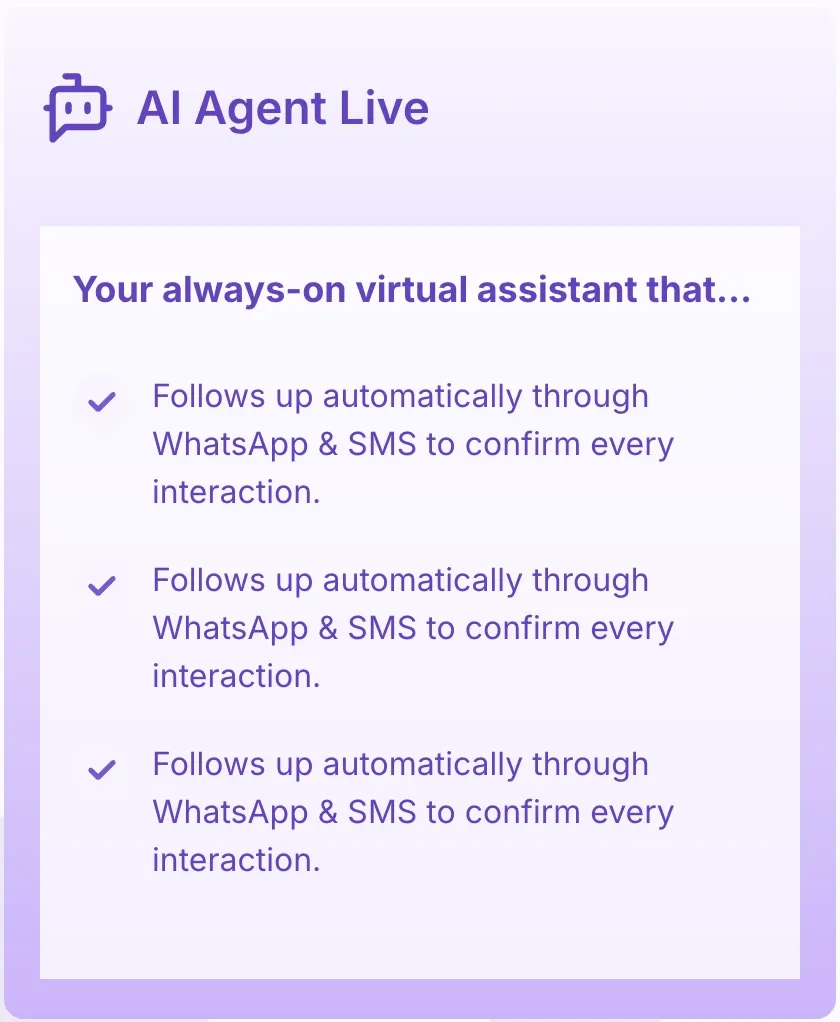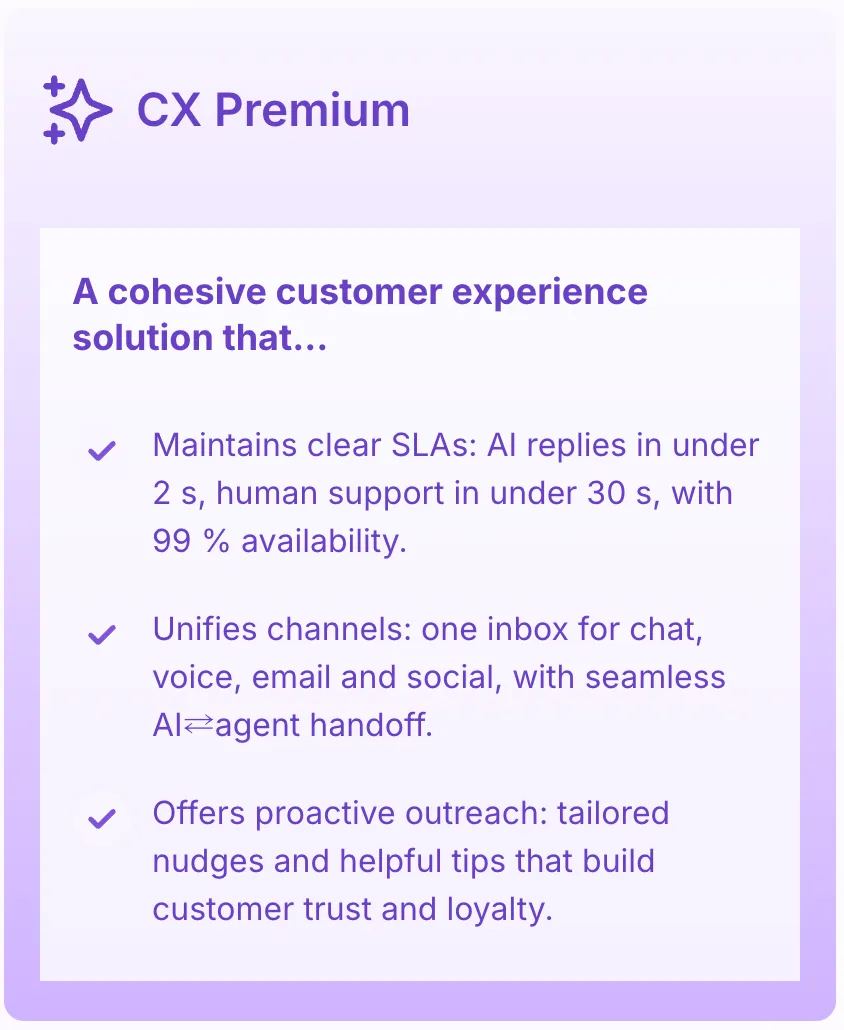In today's fast-paced digital world, automated customer service has become essential for businesses to:
- Meet Rising Customer Expectations
- 90% of consumers want immediate responses
- Support available 24/7
- Options for engaging through multiple channels
- Scale Operations Efficiently
- Manage large volumes of queries
- Cut down on operational costs
- Maintain service quality
Automation does more than just manage basic tasks. Modern AI-powered systems learn from every interaction, allowing for personalized experiences and proactive problem-solving. This shift in technology enables human agents to concentrate on complex issues while automated systems take care of routine questions, creating a balanced approach to customer support that boosts both efficiency and satisfaction.
Understanding the Core Technologies Behind Customer Service Automation
Modern customer service automation relies on four powerful technological pillars that work together to create seamless support experiences:
1. AI Agents: Your 24/7 Support Team
AI agents handle routine customer inquiries with remarkable speed and accuracy. These digital assistants process natural language, understand customer intent, and provide instant responses to common questions about order status, product information, or basic troubleshooting.
2. Machine Learning: The Self-Improving Engine
Machine learning algorithms analyze thousands of customer interactions to:
- Recognize patterns in customer behavior
- Refine response accuracy
- Adapt to new inquiry types
- Learn from successful resolution strategies
3. CRM Integration: Your Customer Memory Bank
Modern CRM systems serve as the central nervous system of customer service automation by:
- Storing detailed interaction histories
- Tracking customer preferences
- Managing support tickets
- Providing agents with real-time customer insights
4. Predictive Analytics: Your Crystal Ball
Predictive analytics transforms raw data into actionable insights:
- Identifies potential issues before they escalate
- Suggests personalized solutions based on customer history
- Optimizes resource allocation during peak support times
- Recommends proactive interventions to prevent customer dissatisfaction
These technologies create a dynamic support ecosystem that learns and improves with each interaction. The combination of AI-powered responses, continuous learning capabilities, comprehensive customer data management, and predictive insights enables businesses to deliver superior automated support experiences.

Key Benefits of Automating Customer Service Processes
Customer service automation transforms support operations with tangible benefits for businesses, customers, and support teams alike.
1. Enhanced Efficiency and Response Times
- Instant responses to common customer inquiries 24/7
- Automated ticket routing cuts resolution time by up to 80%
- Simultaneous handling of multiple customer interactions
- Elimination of queue times for basic support requests
2. Consistent Service Delivery
- Standardized responses across all communication channels
- Uniform brand voice and messaging
- Equal service quality regardless of time or channel
- Reliable support experience for every customer interaction
3. Cost-Effective Operations
- Reduced staffing needs for after-hours support
- Lower cost-per-interaction for routine inquiries
- Minimized training expenses for basic support tasks
- Scalable support without proportional cost increase
4. Improved Agent Experience
- Focus on complex, high-value customer interactions
- Reduced repetitive task burden
- Higher job satisfaction through meaningful work
- Enhanced problem-solving opportunities
5. Customer Satisfaction Impact
- Self-service options for immediate issue resolution
- Personalized support based on customer history
- Proactive problem identification and resolution
- Round-the-clock availability for urgent matters
These automation benefits create a ripple effect throughout your support ecosystem. Studies show businesses implementing customer service automation see a 40% increase in team productivity and a 25% rise in customer satisfaction scores.
Implementing Customer Service Automation: Best Practices and Strategies
Successful implementation of customer service automation requires a strategic approach focused on your organization's specific needs and capabilities.
Step 1: Assessment and Planning
- Analyze current support workflows
- Identify repetitive tasks suitable for automation
- Map customer journey touchpoints
- Document existing pain points in service delivery
Step 2: Technology Selection
- Research automation platforms compatible with your needs
- Verify integration capabilities with existing CRM systems
- Test AI agent responsiveness and accuracy
- Evaluate scalability options for future growth
Step 3: Integration Process
- Set up API connections between systems
- Configure automated workflows
- Create response templates
- Establish routing rules for ticket management
Step 4: Team Training
- Provide hands-on training sessions
- Create documentation for new processes
- Set performance metrics
- Build feedback channels for continuous improvement
Maintaining Service Quality
- Set up automated quality checks
- Create escalation paths for complex issues
- Monitor AI agent accuracy rates
- Implement real-time performance tracking
Balance Automation with Human Touch
- Define scenarios requiring human intervention
- Create clear handoff protocols
- Set up sentiment analysis triggers
- Design hybrid service models combining AI and human support
Your automation implementation should prioritize both efficiency gains and service quality. Regular system audits help identify areas for optimization while maintaining personalized customer experiences through strategic human touchpoints.
Exploring Popular Automation Tools and Features in Customer Support
Modern customer support relies on three essential automation pillars that streamline service delivery and enhance user experience:
1. Knowledge Base Systems
- AI-powered search functionality for instant answers
- Interactive tutorials with step-by-step guidance
- Video demonstrations of common procedures
- Regular content updates based on customer queries
- Mobile-responsive design for on-the-go access
2. Intelligent Routing Technology
- Smart categorization of incoming requests
- Priority-based query distribution
- Skills-based routing to specialized agents
- Language matching for global support teams
- Real-time workload balancing
3. Automated Ticketing Solutions
- Instant ticket creation from multiple channels
- Status tracking and automated updates
- SLA monitoring and deadline alerts
- Custom workflow rules and triggers
- Integrated reporting dashboards
These tools work together to create a seamless support ecosystem. Knowledge bases empower customers to solve issues independently, reducing ticket volume by up to 60%. Intelligent routing ensures queries reach the right expert within minutes, while automated ticketing transforms complex support processes into manageable workflows.
Top platforms like Zendesk, Freshdesk, and Intercom combine these features with advanced analytics capabilities. You can track resolution times, identify bottlenecks, and measure customer satisfaction scores directly through these integrated systems.

Real-world Examples of Customer Service Automation Across Industries
The travel industry showcases powerful applications of customer service automation. Airlines revolutionize booking experiences through AI-powered systems that:
- Handle flight changes and cancellations automatically
- Send real-time updates about gate changes or delays
- Provide instant baggage tracking information
- Suggest alternative routes during disruptions
Airbnb implements automated messaging systems to coordinate check-ins, provide local recommendations, and answer property-specific questions without human intervention.
In the software industry, automation transforms technical support. Microsoft utilizes AI chatbots to:
- Diagnose common Windows issues
- Guide users through software installations
- Reset passwords and manage account access
- Provide immediate solutions for Office 365 problems
Slack demonstrates effective automation through its help center bot that:
- Resolves workspace permission issues
- Troubleshoots integration problems
- Explains feature functionality
- Assists with custom emoji creation
Banking sector automation shows impressive results:
- Bank of America's virtual assistant "Erica" handles millions of customer queries monthly
- Chase's automated system processes loan applications in minutes
- Wells Fargo's AI analyzes customer spending patterns to prevent fraud
These real-world applications highlight how automation adapts to specific industry needs while maintaining service quality and improving customer satisfaction rates.

Measuring the Impact of Automation on Business Metrics and Customer Loyalty
Data shows a strong link between automated customer service efficiency and business success. Companies using automation solutions see a 2x increase in customer repurchase rates when problems are solved within minutes.
Key Performance Indicators (KPIs) Demonstrating Automation's Impact on Business Growth:
- Response Time Reduction: 85% decrease in initial response time
- Customer Satisfaction Scores: 30% improvement in CSAT metrics
- Resolution Rate: 40% increase in first-contact resolution
- Customer Retention: 25% boost in customer lifetime value
Data analysis from automated interactions provides valuable insights for personalization strategies. AI-powered systems monitor customer preferences, purchase history, and interaction patterns to create customized experiences:
- Predictive product recommendations
- Customized communication timing
- Personalized service offerings
- Targeted promotional campaigns
Companies using automation data report significant improvements in customer engagement:
"Our automated system analyzes customer behavior patterns to predict needs and preferences. This proactive approach has increased our customer retention rate by 35%" - Leading e-commerce platform
The combination of automation analytics with CRM systems allows businesses to:
- Identify at-risk customers before they churn
- Create targeted retention campaigns
- Develop personalized loyalty programs
- Track customer journey touchpoints
These data-driven insights help businesses improve their automation strategies and provide increasingly personalized experiences that strengthen customer relationships and foster long-term loyalty.
Challenges and Considerations When Adopting Customer Service Automation
Customer service automation brings powerful benefits, yet organizations must navigate several critical challenges during implementation:
1. System Misinterpretation Issues
- AI agents can misunderstand complex customer queries
- Automated responses might not capture emotional context
- Language nuances and regional dialects pose interpretation challenges
- Technical jargon can lead to incorrect solution suggestions
2. Human Touch Balance
- Customers feel frustrated when stuck in automation loops
- Complex issues require empathy and creative problem-solving
- Some customers prefer speaking directly to human agents
- Critical situations demand immediate human intervention
3. Implementation Roadblocks
- Staff resistance to new automated systems
- Integration challenges with existing technology stack
- Training requirements for both staff and customers
- Initial setup costs and resource allocation
4. Best Practices for Success
- Implement clear escalation paths to human agents
- Add prominent "Contact Representative" options
- Create hybrid support models combining automation and human support
- Regular system audits to identify and fix interpretation gaps
- Collect customer feedback on automated interactions
The key lies in viewing automation as a complement to human support rather than a replacement. Your automated system should enhance the customer experience while maintaining the option for human connection when needed.

Future Trends in Customer Service Automation
The world of customer service automation is constantly changing with new and exciting developments. One major change is the introduction of voice-enabled virtual assistants, which are transforming the way businesses communicate with their customers. These AI-powered solutions have the ability to understand natural language, recognize emotions, and engage in conversations that sound human-like in multiple languages.
Key Innovations in Voice Technology:
- Improvements in natural language processing to recognize different accents
- The ability for voice responses to convey emotions
- Support for multiple languages without any delays in translation
- Enhanced security verification using voice biometrics
Conversational AI agents have evolved from basic chatbots to advanced problem-solving partners, enabling real-time troubleshooting. These sophisticated systems can:
- Predictively analyze and diagnose technical issues
- Provide visual aids alongside step-by-step instructions
- Continuously learn from each interaction to enhance future responses
- Tailor solutions based on feedback received from customers
The scalability of customer support operations has reached new heights through AI-driven process evolution. Businesses can now handle millions of customer interactions simultaneously while maintaining personalized service quality. This scalability extends to:
- Allocating resources dynamically during busy periods
- Adjusting workflows automatically based on demand
- Quickly implementing new support features
- Synchronizing customer data across different platforms
Emerging technologies such as augmented reality integration empower support agents to offer remote visual assistance, while blockchain ensures secure management of customer data within automated systems.
Conclusion
Customer service automation is a game-changer for businesses today. It offers more than just improved efficiency:
- Enhanced Customer Experience
- Support available 24/7
- Instant responses
- Personalized interactions at scale
- Operational Excellence
- Lower support costs
- Streamlined workflows
- Data-driven decision making
To ensure successful automation, it's crucial to monitor and refine the process continuously. Your strategy should adapt to changing customer needs and technological advancements. Regularly auditing your system, tracking performance metrics, and analyzing customer feedback will lay a strong foundation for long-term success.
The future of customer support lies in finding the right balance between automated efficiency and human touch. By implementing intelligent automation solutions while still allowing for human intervention when necessary, businesses can create a support system that boosts customer satisfaction and loyalty in an increasingly digital world.
FAQs (Frequently Asked Questions)
What is customer service automation and why is it important in modern support environments ?
Customer service automation refers to the use of AI-driven processes and technologies to streamline customer support operations. It is important because it enhances efficiency, reduces response times, ensures consistency in service delivery, and lowers operational costs in today's fast-paced support environments.
Which core technologies power effective customer service automation ?
Key technologies behind customer service automation include AI agents that handle routine inquiries, machine learning to improve interactions over time, CRM systems for managing customer data, predictive analytics to anticipate issues proactively, and conversational AI agents that facilitate natural communication with customers.
What are the primary benefits of automating customer service processes ?
Automating customer service improves customer satisfaction by providing quick responses, reduces response times, ensures consistent service across multiple channels, cuts down service costs by handling routine tasks automatically, and enhances agent experience by freeing them to focus on complex issues.
How can organizations successfully implement customer service automation ?
Successful implementation involves assessing organizational needs to identify automatable tasks, selecting appropriate platforms that integrate with existing technology stacks like CRM and ticketing systems, training support teams on automation tools, and maintaining a balance between automated processes and human interaction to preserve personalized service.
What popular tools and features are used in customer support automation ?
Popular automation tools include comprehensive knowledge bases with FAQs and tutorials for self-service, intelligent routing systems that direct queries efficiently to the right departments or agents, and automated ticketing systems that streamline issue resolution and workflow management.
What challenges should businesses consider when adopting customer service automation ?
Challenges include potential misinterpretation by automated systems leading to service gaps, the need to balance automation with human touch to maintain personalized experiences, and ensuring customers always have the option to connect with human representatives when necessary.








